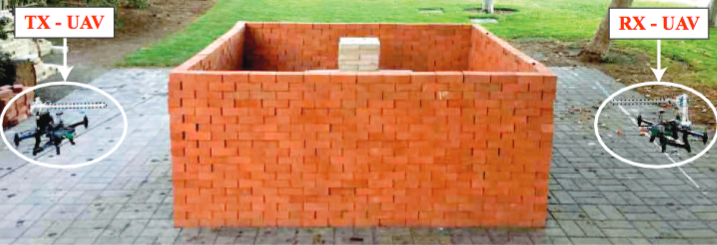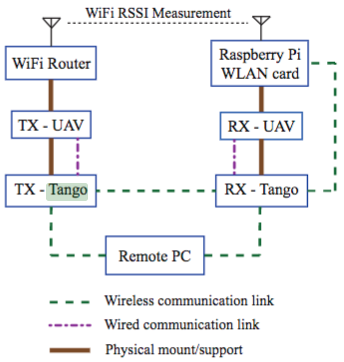Two drones see through walls in 3D using WiFi signals
June 21, 2017

Transmit and receive drones perform 3D imaging through walls using WiFi (credit: Chitra R. Karanam and Yasamin Mostofi/ACM)
Researchers at the University of California Santa Barbara have demonstrated the first three-dimensional imaging of objects through walls using an ordinary wireless signal.
Applications could include emergency search-and-rescue, archaeological discovery, and structural monitoring, according to the researchers. Other applications could include military and law-enforcement surveillance.
Calculating 3D images from WiFi signals
In the research, two octo-copters (drones) took off and flew outside an enclosed, four-sided brick structure whose interior was unknown to the drones. One drone continuously transmitted a WiFi signal; the other drone (located on a different side of the structure) received that signal and transmitted the changes in received signal strength (“RSSI”) during the flight to a computer, which then calculated 3D high-resolution images of the objects inside (which do not need to move).

Structure and resulting 3D image (credit: Chitra R. Karanam and Yasamin Mostofi/ACM)
Interestingly, the equipment is all commercially available: two drones with “yagi” antenna, WiFi router, Tango tablet (for real-time localization), and Raspberry Pi computer with network interface to record measurements.
This development builds on previous 2D work by professor Yasamin Mostofi’s lab, which has pioneered sensing and imaging with everyday radio frequency signals such as WiFi. Mostofi says the success of the 3D experiments is due to the drones’ ability to approach the area from several angles, and to new methodology* developed by her lab.
The research is described in an open-access paper published April 2017 in proceedings of the Association for Computing Machinery/Institute of Electrical and Electronics Engineers International Conference on Information Processing in Sensor Networks (IPSN).
A later paper by Technical University of Munich physicists also reported a system intended for 3D imaging with WiFi, but with only simulated (and cruder) images. (An earlier 2009 paper by Mostofi et al. also reported simulated results for 3D see-through imaging of structures.)

Block diagram of the 3D through-wall imaging system (credit: Chitra R. Karanam and Yasamin Mostofi/ACM)
* The researchers’ approach to enabling 3D through-wall imaging utilizes four tightly integrated key components, according to the paper.
(1) They proposed robotic paths that can capture the spatial variations in all three dimensions as much as possible, while maintaining the efficiency of the operation.
(2) They modeled the three-dimensional unknown area of interest as a Markov Random Field to capture the spatial dependencies, and utilized a graph-based belief propagation approach to update the imaging decision of each voxel (the smallest unit of a 3D image) based on the decisions of the neighboring voxels.
(3) To approximate the interaction of the transmitted wave with the area of interest, they used a linear wave model.
(4) They took advantage of the compressibility of the information content to image the area with a very small number of WiFi measurements (less than 4 percent).
Mostofi Lab | X-ray Eyes in the Sky: Drones and WiFi for 3D Through-Wall Imaging
Abstract of 3D Through-Wall Imaging with Unmanned Aerial Vehicles Using WiFi
In this paper, we are interested in the 3D through-wall imaging of a completely unknown area, using WiFi RSSI and Unmanned Aerial Vehicles (UAVs) that move outside of the area of interest to collect WiFi measurements. It is challenging to estimate a volume represented by an extremely high number of voxels with a small number of measurements. Yet many applications are time-critical and/or limited on resources, precluding extensive measurement collection. In this paper, we then propose an approach based on Markov random field modeling, loopy belief propagation, and sparse signal processing for 3D imaging based on wireless power measurements. Furthermore, we show how to design ecient aerial routes that are informative for 3D imaging. Finally, we design and implement a complete experimental testbed and show high-quality 3D robotic through-wall imaging of unknown areas with less than 4% of measurements.